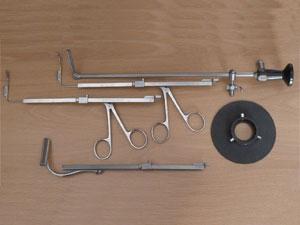Re-discovered in the 1970s
 Nephroscopy was first described by Rupel and Brown in 1941. They introduced a paediatric panendoscope over a nephrostomy tube into the kidney. A stone was seen and removed with Lowsley’s biopsy forceps.
Nephroscopy was first described by Rupel and Brown in 1941. They introduced a paediatric panendoscope over a nephrostomy tube into the kidney. A stone was seen and removed with Lowsley’s biopsy forceps.
Nephrostomy was revisited in the 1970’s. At that time it was an open procedure; the kidney was mobilised and a nephroscope (pictured), or a paediatric panendoscope, was introduced via a pyelotomy. With this technique, both the nephroscope and the kidney itself could be moved and manipulated to get a good view of all the calyces.
However, this was a traumatic way of removing small renal stones so, in 1976, Fernstrom and Johansson described a procedure where a renal pelvic calculus could be extracted through a percutaneous tract.
The first description of percutaneous nephrostomy was by Thomas Hillier in 1865. He drained a 4-year-old boy's kidney, which he believed to be congenitally obstructed. He performed multiple nephrostomies between 1863 and 1868 in an attempt to relieve the patient's abdominal distention, hoping to create a permanent fistula to the skin. The child eventually died 5 years later. Percutaneous renal procedures received no further attention until the mid-1950s.
Goodwin provided the next description of percutaneous renal access in 1955 reporting experience with therapeutic, percutaneous nephrostomies in 16 patients.
Read Goodwin's articley
After Fernstrom and Johansson in 1976, and Alken and Gunther in 1978, this technique was championed in Britain by John Wickham who published his first series of four cases of PCNL in 1981.
Read John Wickham's article
← Back to Kidneys